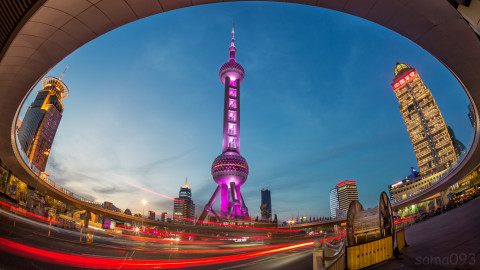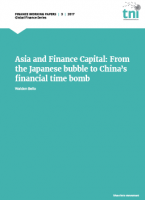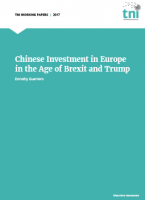Asia’s financial crisis came a decade before the global crisis, but it has had a lasting influence and left a legacy that could sow the seeds for the next global crisis.

https://www.flickr.com/photos/sama093/
How did the Asian financial crisis in 1997-1998 differ to the one that broke in the US and Europe in 2008?
The Asian financial crisis in 1997-98 was similar to the 2008 global financial crisis in that it was also the product of speculative bubbles in real estate and the stock market created by the search for high profits by finance capital. The difference was the role of currency speculators and hedge fund operators in hastening the bursting of the bubble and the collapse of the real economy; these actors played a negligible role in the 2008 crisis. These speculators, led by George Soros’ Quantum Fund, targeted the overvalued currencies of the Asian economies, particularly the Thai baht, betting on the probability that they would be devalued relative to the dollar owing to investor fears that the bubbles would burst, thus accelerating the devaluation of the currencies and making tremendous profits once the Asian currencies were devalued. Had the speculators not been active, the bubbles would still have burst and the real economy would still have entered into severe crisis, but the “landing” would have probably been less rough.
Where the uniqueness of the 2008-2009 crisis lay was in the fatal marriage of a real estate bubble with financial engineering. Tremendous amounts of cash flowed into real estate that were plowed into loans, a great many of them of dubious quality because the debtors’ capacity to repay the loans was questionable– thus the term subprime loans. Financial engineering allowed mortgage originators to slice, dice, and package these loans into securities that were then sold to banks and other financial institutions, which then resold them to other banks and financial institutions. When the mortgage holders could no longer service their mortgages, the quality of the loans was drastically impaired. But billions of dollars of these now toxic securities were circulating in the global financial system, upending the balance sheets of the US and foreign banks and institutions that held them and driving many, like Lehman Brothers, to bankruptcy, and others, like Citi and the German regional banks, requiring a massive government rescue.
What were the underlying causes of the 1997 Asian financial crisis?
The underlying causes were the “push” of finance capital to have a piece of the so-called Asian economic miracle and the “pull” of the Asian corporate elites and governments to bring in capital to feed their investment-hungry export oriented economies. By liberalizing their capital accounts and investment regimes, the latter did trigger an inflow of foreign capital, but this went mainly to real estate and the stock market, creating speculative bubbles in these sectors. When the bubbles burst, with the help of currency speculators and hedge funds, they brought down the real economy, forcing the stricken Asian governments to resort to borrowing from the International Monetary Fund and the US to pay off their debt obligations as well as those of their private sectors.
In the long view, however, the Asian financial crisis was one key moment of the crisis of overproduction that has plagued the global economy since the 1970’s, as investment in productive activity became less and less profitable, resulting in more and more capital being channelled to speculative activity, or making money out of money.
You talk about the Japanese bubble in your paper. What was it? And how did Japanese government’s policy response impact on both Japanese and Southeast Asian economies?
The Japanese bubble economy stemmed from tremendous overinvestment in the productive sector that reduced profitability and encouraged the banks to lend to enterprises engaged in speculative activity like real estate. The magnitude of the bubble that resulted is indicated by the fact that in the late eighties, the Imperial Palace Garden alone in Tokyo was valued as much as all the property in the state of California. When the bubble burst owing to a collapse of demand, many borrowers were left high and dry, leading to a vast accumulation of non-performing loans (NPLs) at the banks. Instead of pushing the banks to clean up their balance sheets, the Ministry of Finance allowed the banks to keep the loans on their books, severely affecting their continued profitability and earning the most impaired the description of “zombie banks.” At the same time, to lift the economy from the resulting recession, the government adopted fiscal and monetary policies that were either too timid or worked at cross purposes as well as neoliberal economic reform efforts that were marked by indecisiveness. The latest attempt to end over 25 years of stagnation is the so-called “Abenomics,” which, after nearly five years, has failed to bring about the desired results.
What was the impact of IMF’s structural adjustment policies imposed on Asian countries that were bailed out?
The IMF’s structural adjustment policies that were imposed on the crisis economies in return for rescue program loans had very negative effects. First of all, the funds the IMF gave were used mainly to repay foreign lenders and investors, with the government merely acting as an intermediary; little was channelled to reviving the domestic economy. Second, the policies the Fund demanded–severe cutbacks in government spending, wage cuts, and a weak currency–worsened the recession into which the crisis economies were plunged. The private sector was collapsing. What should have occurred was countercyclical government intervention, that is government spending to counter the private sector collapse. Instead, you had pro-cyclical policies like government spending cuts, which worsened the recession. Third, the recession created immense human suffering, with some 22 million Indonesians being plunged below the poverty line, as were over one million Thais.
How did China escape the 1997-98 Asian Financial Crisis? And what impact did it have on Chinese economic policy in subsequent decades?
China escaped the 1997-98 Asian financial crisis owing to its barriers to the entry of speculative capital. Despite advice from Western economists to accelerate the opening of its financial sector, China had prevented its currency from being convertible, maintained strong controls on capital flows, and had very little foreign debt. China also did the region a favour by not engaging in competitive devaluation with the stricken economies, which would have prevented them from increasing their exports to gain foreign exchange to pay off their debts and buy much needed imports to resume economic activity.
Paradoxically, however, the crisis accelerated the liberalization of the Chinese financial sector domestically since the reformers led by Prime Minister Zhu Rongji thought that one of the key lessons of the crisis was to avoid the privileged relationships between conglomerates and the banks that funded them which led to corrupt lending practices that made the economy vulnerable to crisis. In other words, the Chinese absorbed what they thought to be the key lessons of two conflicting paradigms: uncontrolled speculation by foreign capital may have triggered the crisis but a deeper cause was “crony capitalism.”
How has Asia been affected by the recent 2008 financial crisis? How did it emerge less scathed than the EU and US?
The Asian economies were affected negatively mainly by the downturn in demand for their exports to Europe and the United States as the financial crisis forced these advanced capitalist economies into recession. However, there was very little exposure among Asian banks to toxic securities like those based on subprime loans, which key US and European banks carried in their balance sheets and nearly ruined them. The Asian financial crisis ten years earlier taught the Asian governments and banks to be very cautious in adopting the products of financial engineering in Wall Street that claimed to eliminate risk.
What reforms have been adopted in Asia, particularly China, to prevent or deal with future financial crises?
There were two key measures that the Asian governments took to prevent future crises. First, they forged a network of bilateral agreements that would promote sharing of reserves among countries if any of them came under attack from currency speculators. Second, and more important, they engaged in intensive export drives to gain massive amounts of foreign exchange, a significant part of which was channelled into their foreign exchange reserves. Reserve accumulation was a response to one of the bitter lessons the Asian governments learned from the Asian financial crisis: you don’t go to the International Monetary Fund for help because that cure would be worse than the disease. From less than one trillion dollars before the Asian financial crisis, East Asian countries accumulated over four trillion dollars by 2008. A large part of these reserves were loaned to the US government through the purchase of US Treasury bills as well as to US banks to fund consumption and speculation, and this helped inflate the US bubble that burst in 2008.
What is the likelihood of a financial crisis in Asia in the near future?
China is a prime candidate to be the site of the next financial crisis. Speculation in real estate and the stock market has been a favoured activity among people who feel they are getting very little interest from their savings in the banks owing to the policy of limiting interest to depositors in order to subsidize the influential export-oriented manufacturing lobby. The Shanghai stock market lost 40 per cent of its value in 2015, bankrupting many investors. That event led many to shift to real estate speculation, with the property sector now overheating in key Chinese cities, like Beijing, which has also translated into a social problem since housing for workers are becoming less and less affordable. Though many local governments are said to be taking measures to dampen housing prices, the speculative fever continues and prices continue to rise.
Speculation in real estate and the stock market is one threat. Another big threat is posed by the rise of shadow banking, which has grown to meet demand for credit that cannot be met by the formal banking institutions, which are tied to privileged borrowers in the export sector. By the end of 2013, the assets of the shadow banking sector came to 51 per cent of GDP. A large part of shadow banking loans was invested in the property sector, so that the bursting of the property bubble could bring down the shadow banking sector. And if the shadow banking sector were to collapse, this would likely bring down the formal banking system as well since many of the creditors in the shadow banking sector have built up their financial resources by borrowing from the formal banking sector. Given the centrality of China in the global economy, a financial crisis there will have an impact on the global economy, though there are differing opinions on how big that impact will be. There is no doubt, however, that since China has become a major source of global demand, the recession that would follow in the footsteps of a financial crisis would drag down many economies that supply raw materials and other inputs to the Chinese industrial machine.


